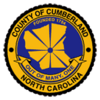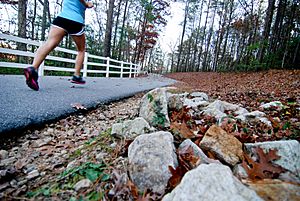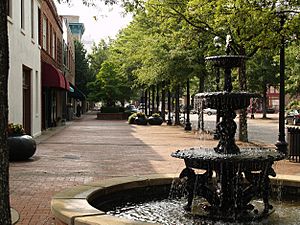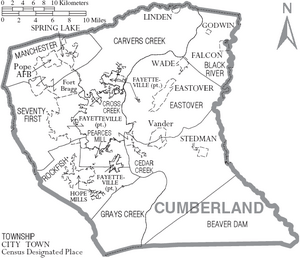Cumberland County, North Carolina facts for kids
Quick facts for kids
Cumberland County
|
|||||
|---|---|---|---|---|---|
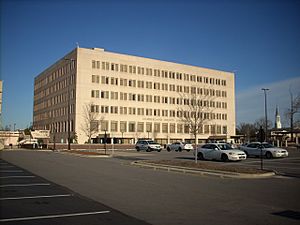
Cumberland County Courthouse in Fayetteville
|
|||||
|
|||||
| Motto(s):
"Out Of Many, One"
|
|||||
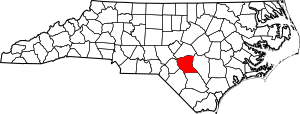
Location within the U.S. state of North Carolina
|
|||||
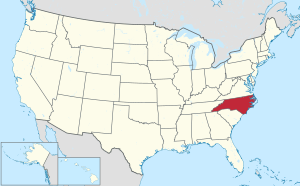 North Carolina's location within the U.S. |
|||||
| Country | |||||
| State | |||||
| Founded | 1754 | ||||
| Named for | Prince William, Duke of Cumberland | ||||
| Seat | Fayetteville | ||||
| Largest community | Fayetteville | ||||
| Area | |||||
| • Total | 658.48 sq mi (1,705.5 km2) | ||||
| • Land | 652.56 sq mi (1,690.1 km2) | ||||
| • Water | 5.92 sq mi (15.3 km2) 0.90% | ||||
| Population
(2020)
|
|||||
| • Total | 334,728 | ||||
| • Estimate
(2023)
|
337,890 | ||||
| • Density | 513.4/sq mi (198.2/km2) | ||||
| Time zone | UTC−5 (Eastern) | ||||
| • Summer (DST) | UTC−4 (EDT) | ||||
| Congressional districts | 7th, 9th | ||||
Cumberland County is a county located in the U.S. state of North Carolina. As of the 2020 census, the population was 334,728, making it the fifth-most populous county in North Carolina. Its county seat is Fayetteville. Cumberland County is part of the Fayetteville, NC Metropolitan Statistical Area.
History
The county was formed in 1754 from Bladen County. It was named for Prince William Augustus, Duke of Cumberland (1721–1765), captain-general of the British army and victorious commander at the Battle of Culloden.
In 1771 parts of Cumberland County, Johnston County, and Orange County were combined to form Wake County. In July 1784 the western part of Cumberland County became Moore County; the eastern part became Fayette County in honor of the Marquis de la Fayette, but the name Cumberland County was restored three months later. The county was represented as Fayette County in the North Carolina General Assembly of April 1784. In 1855 the northern part of Cumberland County became Harnett County. Finally, in 1911 parts of Cumberland County and Robeson County were combined to form Hoke County.
Geography
According to the U.S. Census Bureau, the county has a total area of 658.48 square miles (1,705.5 km2), of which 652.56 square miles (1,690.1 km2) is land and 5.92 square miles (15.3 km2) (0.90%) is water.
State and local protected areas/sites
- Bushy Lake State Natural Area
- Carvers Creek State Park
- Museum of the Cape Fear Historical Complex
- Oak Grove Plantation
- Old Linden School
- Rhodes Pond Game Land (part)
- Suggs Mill Pond Game Land (part)
- Taliaferro's Division Monument
- William T. Smith House
Major water bodies
- Cape Fear River
- Carvers Creek
- Cross Creek
- Hope Mills Lake
- Little River
- Mingo Swamp
- Rockfish Creek
- South River
Adjacent counties
- Harnett County – north
- Sampson County – east
- Bladen County – south
- Robeson County – southwest
- Hoke County – west
- Moore County – west
Major highways
 I-95
I-95 I-95 Bus.
I-95 Bus.




 I-295 / Future I-295
I-295 / Future I-295 US 13
US 13 US 301
US 301 US 401
US 401


 US 401 Bus.
US 401 Bus. NC 24
NC 24 NC 53
NC 53 NC 59
NC 59 NC 82
NC 82 NC 87
NC 87 NC 162
NC 162 NC 210
NC 210 NC 217
NC 217 NC 242
NC 242 NC 295 (temporary highway designation for I-295)
NC 295 (temporary highway designation for I-295) NC 690
NC 690
Major infrastructure
- Fayetteville Regional Airport
- Fayetteville Station
- Fort Liberty (part)
- Pope Army Airfield
- Simmons Army Airfield, military airfield
Demographics
| Historical population | |||
|---|---|---|---|
| Census | Pop. | %± | |
| 1790 | 8,730 | — | |
| 1800 | 9,264 | 6.1% | |
| 1810 | 9,382 | 1.3% | |
| 1820 | 14,446 | 54.0% | |
| 1830 | 14,834 | 2.7% | |
| 1840 | 15,284 | 3.0% | |
| 1850 | 20,610 | 34.8% | |
| 1860 | 16,369 | −20.6% | |
| 1870 | 17,035 | 4.1% | |
| 1880 | 23,836 | 39.9% | |
| 1890 | 27,321 | 14.6% | |
| 1900 | 29,249 | 7.1% | |
| 1910 | 35,284 | 20.6% | |
| 1920 | 35,064 | −0.6% | |
| 1930 | 45,219 | 29.0% | |
| 1940 | 59,320 | 31.2% | |
| 1950 | 96,006 | 61.8% | |
| 1960 | 148,418 | 54.6% | |
| 1970 | 212,042 | 42.9% | |
| 1980 | 247,160 | 16.6% | |
| 1990 | 274,566 | 11.1% | |
| 2000 | 302,963 | 10.3% | |
| 2010 | 319,431 | 5.4% | |
| 2020 | 334,728 | 4.8% | |
| 2023 (est.) | 337,890 | 5.8% | |
| U.S. Decennial Census 1790–1960 1900–1990 1990–2000 2010 2020 |
|||
2020 census
| Race | Number | Percentage |
|---|---|---|
| White (non-Hispanic) | 133,201 | 39.79% |
| Black or African American (non-Hispanic) | 124,173 | 37.1% |
| Native American | 4,647 | 1.39% |
| Asian | 8,943 | 2.67% |
| Pacific Islander | 1,357 | 0.41% |
| Other/Mixed | 22,909 | 6.84% |
| Hispanic or Latino | 39,498 | 11.8% |
As of the 2020 census, there were 334,728 people, 128,135 households, and 78,365 families residing in the county.
2010 census
At the 2010 census, 302,963 people, 107,358 households, and 77,619 families resided in the county. The population density was 464 people per square mile (179 people/km2). The 118,425 housing units had an average density of 181 units per square mile (70 units/km2). The racial makeup of the county was 55.15% White, 34.90% African American, 1.55% Native American, 1.88% Asian, 0.30% Pacific Islander, 3.13% from other races, and 3.09% from two or more races. About 6.90% of the population were Hispanics or Latinos of any race.
By 2005, Cumberland County's population was 51.5% non-Hispanic Whites, 36.7% African American, 6.4% Latino, 3.1% more than one race, 2.1% Asian, and 1.7% Native American.
Of the 107,358 households, 39.4% had children under 18 living with them, 52.9% were married couples living together, 15.5% had a female householder with no husband present, and 27.7% were not families. About 22.4% of all households were made up of individuals, and 5.9% had someone living alone who was 65 or older. The average household size was 2.65, and the average family size was 3.11.
In the county, the age distribution was 27.9% under 18, 13.7% from 18 to 24, 32.9% from 25 to 44, 17.8% from 45 to 64, and 7.7% who were 65 or older. The median age was 30.0 years. For every 100 females, there were 102.30 males. For every 100 females 18 and over, there were 101.90 males.
The median income for a household in the county was $37,466, and for a family was $41,459. Males had a median income of $28,308 versus $22,379 for females. The per capita income for the county was $17,376. About 10.4% of families and 12.8% of the population were below the poverty line, including 16.8% of those under age 18 and 13.70% of those 65 or over.
Education
Cumberland County is home to Fayetteville State University (an HBCU in the CIAA Conference), Methodist University (a member of the USA South Athletic Conference), and Fayetteville Technical Community College.
The Cumberland County Schools district serves most areas for grades PK-12. The Department of Defense Education Activity (DoDEA) operates public schools on Fort Liberty for PK-8, but for high school Fort Liberty students attend local public schools in their respective counties. The Cumberland Schools system is the fourth largest public school system in the state of North Carolina. There are 17 high schools in Cumberland County: Cape Fear, Cross Creek Early College, Cumberland International Early College, Douglas Byrd, E.E. Smith, Fuller Performance Learning Center, Gray's Creek, Howard Health and Life Sciences, Jack Britt, Massey Hill Classical, Pine Forest, Reid Ross Classical, Seventy-First, South View, Terry Sanford, Alger B. Wilkins, Ramsey Street, and Westover.
Cumberland County Public Library and Information Center
The Cumberland County Public Library & and Information Center began as the Fayetteville Library Society after being incorporated by the North Carolina General Assembly in 1794. The Fayetteville Library Society was the first library organization or group to become incorporated in the state of North Carolina. The current library director is Ms. Jody Risacher and she is also a member of the 2018 Library Board of Trustees for Cumberland County. Board of trustee members are appointed every three years by the Cumberland County Board of Commissioners.
Director Risacher was initially hired as the deputy director for the Cumberland County Public Library and Information Center in the late 1990s and became the library's director in 2008. Director Risacher was named the Library Director of the Year by the North Carolina Public Library Association in 2013.
Cumberland County Public Library and Information Center has eight branches: Bordeaux Branch, Cliffdale Regional Branch, East Regional Branch, Headquarters Branch, Hope Mills Branch, North Regional Branch, Spring Lake Branch, and West Regional Branch. The newest branch is the West Regional Branch Library which opened in 2010, and the oldest branch was the Gillespie Street Branch, which originated as the James Walker Hood Library in 1942 and was a branch specifically for African Americans. Its mission statement is “The library opens windows to the world by encouraging expression, enlightenment, and exploration”.
In 2012, the Cumberland County Public Library and Information Center received the National Medal for Museum and Library Service, which is only awarded to five libraries in the United States each year.
In 2018, the Cumberland County Public Library and Information Center won two grants via the American Library Association and the Arts Council of Cumberland County for a total of $5,300.00. One grant was used to support a pilot program at a local high school and the other to support the Cumberland County Storytelling Festival and Artrepreneur program.
The Cumberland County Court Library, which was previously located in the Judge E. Maurice Braswell Courthouse, moved to the Headquarters Library in February 2018. The Court Library is now situated in the Local and State History Room and collection materials are now available to the general public via local libraries. Library staff is available to assist patrons with finding information but they cannot offer patrons legal advice.
Some of the current services offered by the branch libraries include children's, young adult, and adult programming, genealogy and local history, homeschooling resources, and homework help for students. Cumberland County Public Library & Information Center offers patrons access to free downloads for audiobooks, ebooks, magazines, videos, and resources for education purposes. Patrons are able to access these resources remotely online via the use of the patron's library card number and pin. The library branches also offer computer training courses/classes, as well as story times, and opportunities for people or groups in the community to reserve spaces for meetings and programs.
Arts & Culture
An October 2023 study released by Americans for the Arts, (AFTA) found that nonprofit arts and culture organizations in Fayetteville and Cumberland County created $72.2 million in total economic activity in 2022, supported over 1100 jobs, provided $44.1 million in personal income to residents and generated $9.5 million in local, state and federal tax revenue. At an April 2024 event the Arts Council of Fayetteville/Cumberland County announced that arts and cultural activities drew more than 900,000 visitors to the region.
Points of interest
Historic sites
- Cool Spring Tavern
- Evans Metropolitan AME Zion Church
- Ellerslie Plantation
- The first Golden Corral
- Hay Street United Methodist Church
- Heritage Square
Libraries
- Cumberland County Libraries
Museums
- Airborne & Special Operations Museum
- Museum of the Cape Fear Historical Complex
Parks and recreation
- Cape Fear Botanical Garden
Shopping
Theaters and arenas
- Crown Coliseum
Communities
City
- Fayetteville (county seat and largest community)
Towns
Census-designated place
Townships
- Beaver Dam
- Black River
- Carvers Creek
- Cedar Creek
- Cross Creek
- Eastover
- Gray's Creek
- Manchester
- Pearces Mill
- Rockfish
- Seventy-First
See also
 In Spanish: Condado de Cumberland (Carolina del Norte) para niños
In Spanish: Condado de Cumberland (Carolina del Norte) para niños



